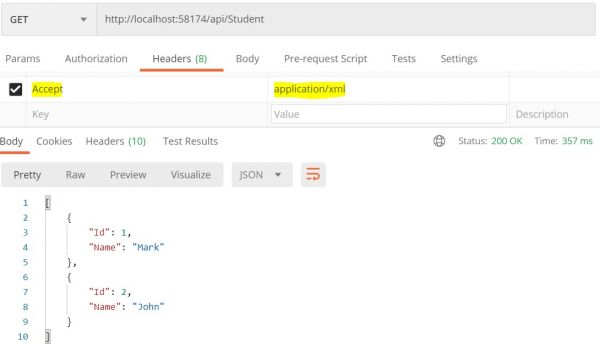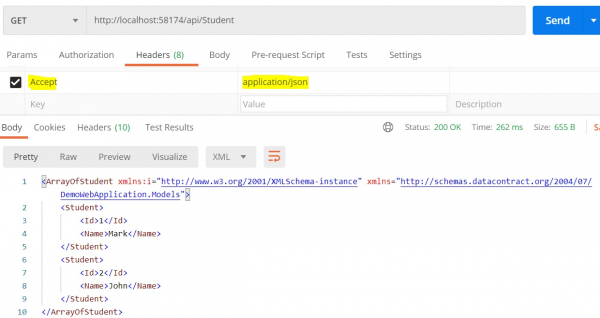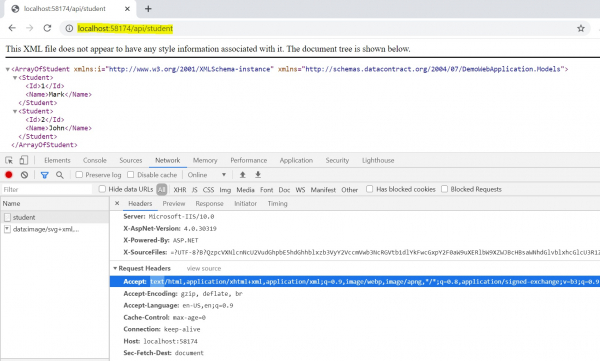How do we specify MIME type in Asp.Net WebAPI C#?
Media type, also called MIME type, identifies the format of a piece of data. In HTTP, media types describe the format of the message body. A media type consists of two strings: type and subtype. For example -
- text/html
- image/png
- application/json
When the client sends a request message, it can include the Accept header. The Accept header tells the server which media type the client expects from the server.
Accepts: text/html,application/xhtml xml,application/xml p>
The media type determines how the Web API serializes and deserializes the HTTP message body. Web API has built-in support for XML, JSON, BSON, and formurlencoded data, and you can support other media types by writing media formatters.
MediaTypeFormatter is an abstract class from which the JsonMediaTypeFormatter and XmlMediaTypeFormatter classes inherit. JsonMediaTypeFormatter handles JSON and XmlMediaTypeFormatter handles XML. The media type is specified in the Register method of the WebApiConfig class. Let's look at some examples where media types can be used.
Student Controller
Example
using DemoWebApplication.Models;
using DemoWebApplication.Models;
using System.Collections.Generic;
using System.Linq;
using System.Web.Http;
namespace DemoWebApplication.Controllers{
public class StudentController : ApiController{
List <Student> students = new List <Student>{
new Student{
Id = 1,
Name = "Mark"
},
new Student{
Id = 2,
Name = "John"
}
};
public IEnumerable <Student> Get(){
return students;
}
}
}Example of only returning JSON from an ASP.NET Web API service, regardless of Accept header value -
public static class WebApiConfig{
public static void Register(HttpConfiguration config){
config.MapHttpAttributeRoutes();
config.Formatters.Remove(config.Formatters.XmlFormatter);
config.Routes.MapHttpRoute(
name: "DefaultApi",
routeTemplate: "api/{controller}/{id}",
defaults: new { id = RouteParameter.Optional }
);
}
}With the above code, we removed the XmlFormatter, which forces ASP.NET Web API to always return JSON regardless of the Accept header value in the client request. Use this technique when you want your service to support only JSON instead of XML.

From the above output we can see that the Web API service always returns JSON regardless of the Accept header value application/xml.
Example of returning only XML from ASP.NET Web API service regardless of Accept header value -
public static class WebApiConfig{
public static void Register(HttpConfiguration config){
config.MapHttpAttributeRoutes();
config.Formatters.Remove(config.Formatters.JsonFormatter);
config.Routes.MapHttpRoute(
name: "DefaultApi",
routeTemplate: "api/{controller}/{id}",
defaults: new { id = RouteParameter.Optional }
);
}
}
From the above output we can see that whatever the Accept header value application/json is, the Web API service returns XML.
Example of returning JSON instead of XML from ASP.NET Web API service in the following situations Browser makes request -
When the browser makes a request to our StudentController, the response will be in XML format. This is because browsers send accept headers as text/html by default.

Now let’s see how to send a JSON response instead of XML when making a request from the browser.
public static class WebApiConfig{
public static void Register(HttpConfiguration config){
config.MapHttpAttributeRoutes();
config.Formatters.JsonFormatter.SupportedMediaTypes.Add(new
MediaTypeHeaderValue("text/html"));
config.Routes.MapHttpRoute(
name: "DefaultApi",
routeTemplate: "api/{controller}/{id}",
defaults: new { id = RouteParameter.Optional }
);
}
}The output below shows that when the request is triggered from the browser, the response is of type JSON regardless of the accept header text/html.

The above is the detailed content of How do we specify MIME type in Asp.Net WebAPI C#?. For more information, please follow other related articles on the PHP Chinese website!

Hot AI Tools

Undresser.AI Undress
AI-powered app for creating realistic nude photos

AI Clothes Remover
Online AI tool for removing clothes from photos.

Undress AI Tool
Undress images for free

Clothoff.io
AI clothes remover

Video Face Swap
Swap faces in any video effortlessly with our completely free AI face swap tool!

Hot Article

Hot Tools

Notepad++7.3.1
Easy-to-use and free code editor

SublimeText3 Chinese version
Chinese version, very easy to use

Zend Studio 13.0.1
Powerful PHP integrated development environment

Dreamweaver CS6
Visual web development tools

SublimeText3 Mac version
God-level code editing software (SublimeText3)

Hot Topics
 1386
1386
 52
52
 What is the role of char in C strings
Apr 03, 2025 pm 03:15 PM
What is the role of char in C strings
Apr 03, 2025 pm 03:15 PM
In C, the char type is used in strings: 1. Store a single character; 2. Use an array to represent a string and end with a null terminator; 3. Operate through a string operation function; 4. Read or output a string from the keyboard.
 How to use various symbols in C language
Apr 03, 2025 pm 04:48 PM
How to use various symbols in C language
Apr 03, 2025 pm 04:48 PM
The usage methods of symbols in C language cover arithmetic, assignment, conditions, logic, bit operators, etc. Arithmetic operators are used for basic mathematical operations, assignment operators are used for assignment and addition, subtraction, multiplication and division assignment, condition operators are used for different operations according to conditions, logical operators are used for logical operations, bit operators are used for bit-level operations, and special constants are used to represent null pointers, end-of-file markers, and non-numeric values.
 How to handle special characters in C language
Apr 03, 2025 pm 03:18 PM
How to handle special characters in C language
Apr 03, 2025 pm 03:18 PM
In C language, special characters are processed through escape sequences, such as: \n represents line breaks. \t means tab character. Use escape sequences or character constants to represent special characters, such as char c = '\n'. Note that the backslash needs to be escaped twice. Different platforms and compilers may have different escape sequences, please consult the documentation.
 The difference between char and wchar_t in C language
Apr 03, 2025 pm 03:09 PM
The difference between char and wchar_t in C language
Apr 03, 2025 pm 03:09 PM
In C language, the main difference between char and wchar_t is character encoding: char uses ASCII or extends ASCII, wchar_t uses Unicode; char takes up 1-2 bytes, wchar_t takes up 2-4 bytes; char is suitable for English text, wchar_t is suitable for multilingual text; char is widely supported, wchar_t depends on whether the compiler and operating system support Unicode; char is limited in character range, wchar_t has a larger character range, and special functions are used for arithmetic operations.
 The difference between multithreading and asynchronous c#
Apr 03, 2025 pm 02:57 PM
The difference between multithreading and asynchronous c#
Apr 03, 2025 pm 02:57 PM
The difference between multithreading and asynchronous is that multithreading executes multiple threads at the same time, while asynchronously performs operations without blocking the current thread. Multithreading is used for compute-intensive tasks, while asynchronously is used for user interaction. The advantage of multi-threading is to improve computing performance, while the advantage of asynchronous is to not block UI threads. Choosing multithreading or asynchronous depends on the nature of the task: Computation-intensive tasks use multithreading, tasks that interact with external resources and need to keep UI responsiveness use asynchronous.
 How to convert char in C language
Apr 03, 2025 pm 03:21 PM
How to convert char in C language
Apr 03, 2025 pm 03:21 PM
In C language, char type conversion can be directly converted to another type by: casting: using casting characters. Automatic type conversion: When one type of data can accommodate another type of value, the compiler automatically converts it.
 What is the function of C language sum?
Apr 03, 2025 pm 02:21 PM
What is the function of C language sum?
Apr 03, 2025 pm 02:21 PM
There is no built-in sum function in C language, so it needs to be written by yourself. Sum can be achieved by traversing the array and accumulating elements: Loop version: Sum is calculated using for loop and array length. Pointer version: Use pointers to point to array elements, and efficient summing is achieved through self-increment pointers. Dynamically allocate array version: Dynamically allocate arrays and manage memory yourself, ensuring that allocated memory is freed to prevent memory leaks.
 How to use char array in C language
Apr 03, 2025 pm 03:24 PM
How to use char array in C language
Apr 03, 2025 pm 03:24 PM
The char array stores character sequences in C language and is declared as char array_name[size]. The access element is passed through the subscript operator, and the element ends with the null terminator '\0', which represents the end point of the string. The C language provides a variety of string manipulation functions, such as strlen(), strcpy(), strcat() and strcmp().




